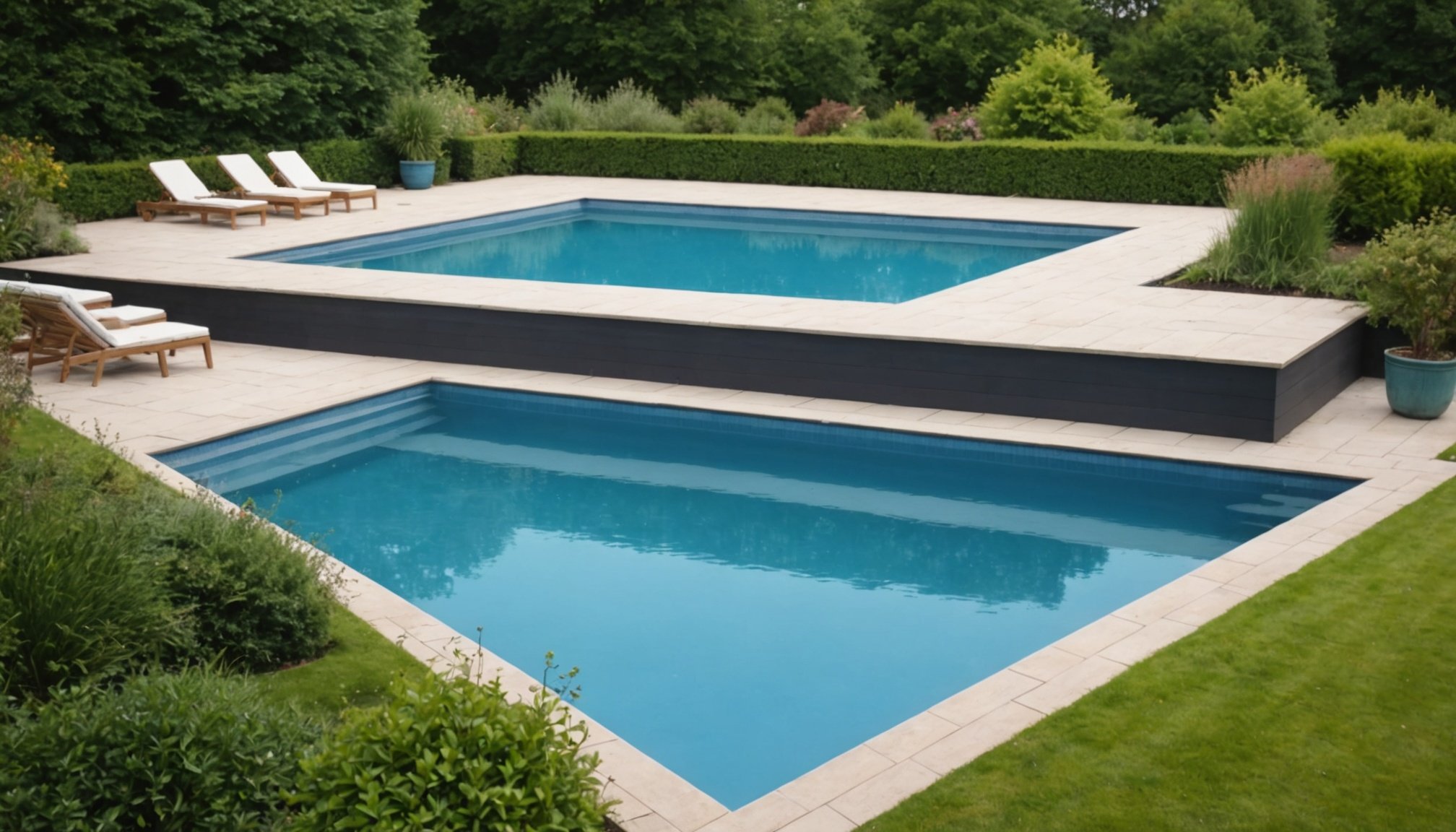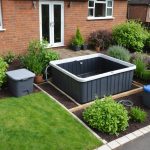Understanding Pool Coping in Damp Climates
Pool coping serves as both a protective and aesthetic feature for outdoor pools, effectively sealing the pool’s edge. However, in places with damp weather, like much of the UK, specific challenges arise. This damp climate poses a significant risk to the longevity of pool coping.
In damp conditions, the constant presence of moisture impacts the durability of the materials used. For example, while stone or concrete pool coping might appear robust, they can absorb water, leading to deterioration over time. The persistent moisture can cause these materials to crack or erode, severely affecting their longevity.
Avez-vous vu cela : Effective Strategies to Reduce the Visual Disruption of Pool Safety Fences in UK Gardens
To combat these issues, selecting materials specifically designed to withstand damp weather is crucial. Options like porcelain tiles or high-quality composites are less porous, thus more resistant to moisture. They maintain their integrity, ensuring the pool’s safety and aesthetic are preserved for longer periods.
In addition to material choice, proper sealing and maintenance are essential practices. Regular inspection and resealing can mitigate the impact of moisture, extending the life of the pool coping. Understanding and addressing these specific challenges can ensure that pool coping remains both functional and visually appealing, despite challenging weather conditions.
A voir aussi : Ultimate Guide to Balancing pH Levels for Your UK Home Swimming Pool
Best Materials for Pool Coping in the UK
Choosing the best pool coping materials is crucial for longevity and performance. Let’s explore options that are durable and weather-resistant.
Stone Options
Natural stone is often hailed for its exceptional durability. It not only withstands harsh weather conditions but also adds a timeless aesthetic appeal to the pool area. Popular choices include limestone, sandstone, and granite. These materials offer a sturdy surface and resist wear over time. Moreover, stone offers a premium feel, making it a top choice for many.
Concrete Solutions
Concrete remains a popular solution due to its resilience in moist environments. When correctly treated, concrete exhibits superb weather resistance, standing up to both rain and sun. It can be moulded into various designs, providing aesthetic flexibility. Additionally, textured finishes can prevent slipping, enhancing safety around the pool.
Composite Materials
Innovative composite materials combine various elements, offering both flexibility and strength. They are engineered to resist UV light and moisture, reducing the risk of cracking or warping. These materials also mimic the visual appeal of natural stones but are lightweight and easier to install. They provide a balance of aesthetics and practicality for modern pool designs.
Maintenance Strategies for Enhanced Longevity
Maintaining your pool is essential for prolonged enjoyment and efficiency. Effective pool care goes beyond mere cleaning; it involves routine practices and inspections to extend the lifespan of your pool and its components.
Begin with systematic maintenance, focusing on regular cleaning practices. This not only prevents wear and tear but also significantly enhances the overall durability of your pool. Skimming, vacuuming, and brushing are fundamental tasks that should be performed weekly to eliminate debris and algae. Regular cleaning maintains not only aesthetics but also functionality, ensuring uninterrupted enjoyment.
Inspections play a crucial role in pool care. By evaluating the structure and equipment periodically, you can identify potential issues such as leaks or cracks. Early detection prevents minor problems from escalating, preserving the integrity of your pool and avoiding costly repairs. Attend to your pool’s coping as part of your inspection routine, ensuring it’s free from concealed damages.
Lastly, adapt maintenance efforts to the seasons. Preparing for wet conditions with appropriate measures protects your pool from potential damage. Remove surrounding debris to prevent blockages and employ covers to maintain cleanliness. These seasonal tips can fortify your pool against environmental challenges, maintaining its condition and extending its lifespan effectively.
Protective Coatings for Pool Coping
Protective coatings play a crucial role in maintaining the structural integrity of pool coping. By providing a layer that safeguards against water intrusion, these coatings significantly enhance the longevity of your pool’s edges. An effective waterproofing strategy is essential to prevent damage and minimise upkeep.
Types of Sealants
Various sealants are available, each with unique characteristics suitable for different pool environments. Silicone-based sealants offer flexible protection, ideal for irregular surfaces. Conversely, acrylic sealants are known for their UV resistance, making them suitable for outdoor settings with heavy sunlight exposure. Polyurethane sealants provide robust waterproofing, which is perfect for areas with frequent rainfall or splashes.
Application Techniques
For optimal results, applying protective coatings requires methodical approaches. Start with a clean, dry surface. Use a brush or roller for even coverage, ensuring that all crevices are filled to prevent potential leaks. Allow each coat to dry thoroughly before applying additional layers, which might be necessary depending on the sealant used and the exposure level.
Frequency of Reapplication
To ensure continued effectiveness, reapplication is key. Typically, protective treatments are recommended every 2-3 years, depending on environmental conditions and pool usage. Regular inspections can help determine if earlier reapplication is needed to maintain optimal waterproofing and safeguard your investment.
Effective Drainage Solutions
Addressing drainage is crucial to prevent water accumulation, which can damage property and disrupt the ecosystem. When water pools, it can harm foundations and create slippery surfaces. In landscape design, moisture control ensures safety and sustainability.
Design Considerations
Effective drainage around pools requires strategic placement of drains and grading. It’s essential to ensure water flows away from the pool and towards designated drainage systems. This involves creating gradients in pavements or planting areas to direct water runoff appropriately. Using porous materials in paths and patios can also aid in moisture control, reducing water pooling.
Real-World Applications
In damp climates, where water surplus poses significant challenges, some communities have adopted well-designed drainage systems. For instance, in areas renowned for heavy rains, landscape design often involves integrated swales, rain gardens, and strategically positioned drains. These methods have successfully diverted excess water, maintaining comfortable and safe outdoor spaces.
With these solutions, managing water effectively not only protects structures but also enhances the aesthetic appeal of landscapes. Addressing drainage may involve initial costs, yet the long-term benefits, including reduced maintenance and repair expenses, make it a vital aspect of designing any outdoor environment.
Design Considerations for Resilient Pool Coping
Resilient pool coping design requires careful thought in landscape architecture to ensure longevity and efficiency. Implementing effective design strategies like elevation techniques and material grading is essential.
Elevation Techniques
Elevation techniques are pivotal in directing water flow away from pool coping. Strategically elevating the coping can prevent water accumulation, safeguarding the pool structure. This approach involves understanding the pool’s topography and utilizing landscape designs that encourage natural water drainage.
Material Grading
Proper material grading is crucial to avoid pooling water and potential damage. The choice of materials should consider durability and moisture resistance. Techniques include layering materials at slight angles, ensuring water efficiently runs off and away from the coping, contributing to a robust design.
Incorporating Vegetation
Vegetation not only enhances aesthetics but also serves practical purposes in landscape architecture. Planting strategically around pool areas can promote natural moisture absorption. This reduces water buildup around pool coping, further bolstering the structure’s resilience. Consider selecting plants with high water absorption capacity, contributing to a sustainable pool environment.
Expert Insights and Local Examples
In the pursuit of optimal pool maintenance and landscaping, interviews with landscape architects and pool maintenance experts reveal valuable insights. One prominent landscape architect from London highlighted the integration of technology in outdoor spaces. Emphasising the benefit of automatic irrigation systems, they suggest that this approach not only conserves water but also ensures plants receive the right amount of hydration.
Further enriching our understanding, a pool maintenance expert from Manchester shared best practices for maintaining water quality. They advocate for regular monitoring of chemical levels and prompt addressing of any imbalances to prevent long-term damage.
Case Studies of Successful Installations in the UK
Several case studies underscore the effectiveness of expert recommendations. For example, a family-owned garden centre in Cornwall implemented a newly designed irrigation system, resulting in a significant reduction in water consumption and healthier plant life. This case exemplifies how expert advice can lead to tangible improvements.
From these expert insights and local examples, key takeaways include:
- Embrace technology for environmental and maintenance efficiency
- Regular chemical monitoring for pool sustenance
- Consult professionals for tailored solutions
By incorporating these strategies, homeowners can achieve not only aesthetically pleasing but sustainable landscapes and pools.
Conclusion: Future-Proofing Your Pool Coping
Incorporating long-term planning into your pool design and maintenance is crucial for ensuring durability and sustainability. By being proactive, property owners can create an environment that withstands the test of time, showcasing superior outdoor resilience. This involves selecting quality materials that not only enhance the aesthetic appeal of your pool area but also contribute positively to its longevity.
Investing in premium materials and implementing sustainable practices is essential for greater durability. Quality materials reduce the frequency of repairs and replacements, ultimately offering a more cost-effective solution over time. Consider materials like stone or composite options known for their outdoor resilience. These choices not only ensure a sturdy foundation for your pool coping but also a stylish, timeless look.
By following best practices in pool construction and care, you significantly increase the lifespan of your pool. Regular maintenance checks and repairs, when necessary, also play a vital role in maintaining the integrity of your pool coping. The combination of superior materials and diligent care provides peace of mind for property owners, knowing their investment is secure and will continue to delight for years to come.











